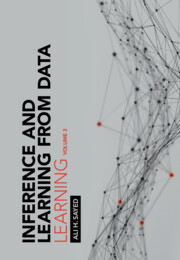Refine search
Actions for selected content:
48284 results in Computer Science
THE ZHOU ORDINAL OF LABELLED MARKOV PROCESSES OVER SEPARABLE SPACES
- Part of
-
- Journal:
- The Review of Symbolic Logic / Volume 16 / Issue 4 / December 2023
- Published online by Cambridge University Press:
- 27 February 2023, pp. 1011-1032
- Print publication:
- December 2023
-
- Article
- Export citation
First checklist triggering the inventory of marine fish ectoparasites in the Syrian coast (Eastern Mediterranean)
-
- Journal:
- Experimental Results / Accepted manuscript
- Published online by Cambridge University Press:
- 27 February 2023, pp. 1-17
-
- Article
-
- You have access
- Open access
- Export citation
Joining forces: the value of design partnering with operational research to improve healthcare delivery
-
- Journal:
- Design Science / Volume 9 / 2023
- Published online by Cambridge University Press:
- 27 February 2023, e4
-
- Article
-
- You have access
- Open access
- HTML
- Export citation
AXIOMS FOR TYPE-FREE SUBJECTIVE PROBABILITY
- Part of
-
- Journal:
- The Review of Symbolic Logic / Volume 17 / Issue 2 / June 2024
- Published online by Cambridge University Press:
- 27 February 2023, pp. 493-508
- Print publication:
- June 2024
-
- Article
- Export citation

Inference and Learning from Data
- Learning
-
- Published online:
- 24 February 2023
- Print publication:
- 22 December 2022
-
- Textbook
- Export citation
Chapter 9 - Hecate
- from Part III - Public Reimaginings
-
-
- Book:
- Reimagining Shakespeare Education
- Published online:
- 02 February 2023
- Print publication:
- 23 February 2023, pp 145-158
-
- Chapter
- Export citation
Introduction
- from Part IV - Digital Reimaginings
-
-
- Book:
- Reimagining Shakespeare Education
- Published online:
- 02 February 2023
- Print publication:
- 23 February 2023, pp 205-208
-
- Chapter
- Export citation
Notes on Contributors
-
- Book:
- Reimagining Shakespeare Education
- Published online:
- 02 February 2023
- Print publication:
- 23 February 2023, pp xiii-xxii
-
- Chapter
- Export citation
Chapter 7 - The Warwick–Monash Co-teaching Initiative
- from Part II - Reimagining Shakespeare with/in Universities
-
-
- Book:
- Reimagining Shakespeare Education
- Published online:
- 02 February 2023
- Print publication:
- 23 February 2023, pp 113-126
-
- Chapter
- Export citation
Chapter 11 - The Pop-up Globe
- from Part III - Public Reimaginings
-
-
- Book:
- Reimagining Shakespeare Education
- Published online:
- 02 February 2023
- Print publication:
- 23 February 2023, pp 174-187
-
- Chapter
- Export citation
Figures
-
- Book:
- Reimagining Shakespeare Education
- Published online:
- 02 February 2023
- Print publication:
- 23 February 2023, pp x-xi
-
- Chapter
- Export citation
Acknowledgements
-
- Book:
- Reimagining Shakespeare Education
- Published online:
- 02 February 2023
- Print publication:
- 23 February 2023, pp xxiii-xxiv
-
- Chapter
- Export citation
Chapter 6 - The Shakespeare’s Globe/King’s College London MA Shakespeare Studies
- from Part II - Reimagining Shakespeare with/in Universities
-
-
- Book:
- Reimagining Shakespeare Education
- Published online:
- 02 February 2023
- Print publication:
- 23 February 2023, pp 102-112
-
- Chapter
- Export citation
Chapter 17 - Flute Theatre, Shakespeare and Autism
- from Part V - Reimagining Performance
-
-
- Book:
- Reimagining Shakespeare Education
- Published online:
- 02 February 2023
- Print publication:
- 23 February 2023, pp 271-280
-
- Chapter
- Export citation
Chapter 18 - The Viola Project
- from Part V - Reimagining Performance
-
-
- Book:
- Reimagining Shakespeare Education
- Published online:
- 02 February 2023
- Print publication:
- 23 February 2023, pp 281-294
-
- Chapter
- Export citation
Chapter 4 - The Better Strangers/Shakespeare Reloaded Project
- from Part I - Reimagining Shakespeare with/in Schools
-
-
- Book:
- Reimagining Shakespeare Education
- Published online:
- 02 February 2023
- Print publication:
- 23 February 2023, pp 69-84
-
- Chapter
- Export citation
Chapter 16 - Play the Knave Theatre Videogame in Schools
- from Part IV - Digital Reimaginings
-
-
- Book:
- Reimagining Shakespeare Education
- Published online:
- 02 February 2023
- Print publication:
- 23 February 2023, pp 251-264
-
- Chapter
- Export citation
Chapter 12 - The Place of Shakespeare North
- from Part III - Public Reimaginings
-
-
- Book:
- Reimagining Shakespeare Education
- Published online:
- 02 February 2023
- Print publication:
- 23 February 2023, pp 188-202
-
- Chapter
- Export citation
Contents
-
- Book:
- Reimagining Shakespeare Education
- Published online:
- 02 February 2023
- Print publication:
- 23 February 2023, pp vii-ix
-
- Chapter
- Export citation










